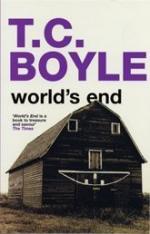|
This section contains 147 words (approx. 1 page at 300 words per page) |

|
In his parody of American history, Boyle's narrative vacillates between the seventeenth century and the twentieth century. The reader thus sees how certain events in America's past have consequences three hundred years later. Furthermore, Boyle uses his double time line to suggest that modern American society is just as chaotic as the American colonies were before the country had a firm identity. Another technique that Boyle uses is the mixture of fiction and history, a device used by many modernist writers of the twentieth century. This technique always suggests that the author is rewriting history or is expressing a desire that history should be rewritten. For example, Boyle's cast of characters includes descendants of Ichabod Crane, a fictional character created by Washington Irving. Mingling with such reincarnated fictional characters are several real historical figures, such as Paul Robeson, the opera singer who had Communist beliefs.
|
This section contains 147 words (approx. 1 page at 300 words per page) |

|




